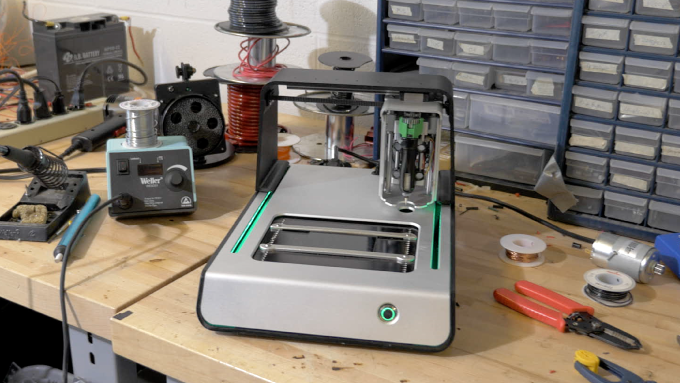Voltera V-One: Fast PCB Fabrication for Electronic Device Prototypes

Creating a printed circuit board in a home or small lab-shop is quite a laborious task. Making the layout, etching, heating and other related tasks take a lot of time and effort from the electronics engineer. Today, few people are engaged in this, they often order from specialized companies - but in this case you have to wait for your order for many days. In the development of electronics, the production of boards for prototypes often significantly slows down the process.
Voltera V-One offered a solution to this problem - a portable station (no larger than an MFP) for printing, sorry for the pun, printed circuit boards. At Kickstarter, the fund-raising company at Voltera V-One, which was shown at CES 2015, is extremely successful.
')
How it works?
The principle of operation of the station is similar to the principle of operation of a conventional inkjet printer. Only as ink here is used a special conductive substance that the “printer” applies to the board. In addition, a special insulator material is used, which isolates the layers from each other if the board is multi-layered. The insulating composition is also applied automatically, using a different type of print head (they change in seconds).
As a result, after downloading the file with the trace of the board, we get it in an hour or two, not days or weeks. What can, on the one hand, significantly speed up the development process, and on the other, increase the number of iterations to optimize the board without losing time. Of course, here we are talking about small series, in a few pieces, because the boards printed on the Voltera V-One are more expensive than regular ones. But nowadays, in the fast electronics market, the difference in price for several boards can be neglected if you gain time. And large series, of course, it is advisable to order "in the old manner."
In addition to the basic functionality, the “printer” should work as a dispenser for soldering paste, which it applies in a few seconds in the right places. Then, at the right moment, the board heats up to the temperature required for melting the paste and components can be mounted on it.

How easy is that?
Print boards
The printer has only one button, and the cartridges change without any problems - the nozzles go on a magnetic basis, there are no complicated mounts. Software, according to the developers, is reliable, and there are no problems with it either.

The process of changing cartridges for printing double-layer boards.

The software tracks the intersecting tracks, and takes into account the places where the intersection occurs, for the subsequent application of an insulating layer.

Wiring components
The manufacturer promises that after applying the solder paste it is enough to install the components and turn on the heat - and the soldered board is ready. This functionality is not yet ready, the developers are now working on a heating module for the Voltera V-One.

Each device comes with a set of development boards with already drilled holes for today's most common solutions. At the start, this is the Arduino Uno and Mega. Further plans to add other fees.

Specifications



How much does it cost, and when to wait on sale?
On pre-order, the Voltera V-One is available for $ 1,200 . After entering the market, the device will cost about 1,700 US dollars.
The first batch of devices will be shipped in September 2015, the second batch will go to the "investors" in January 2016.
Your djadget
Source: https://habr.com/ru/post/376989/
All Articles